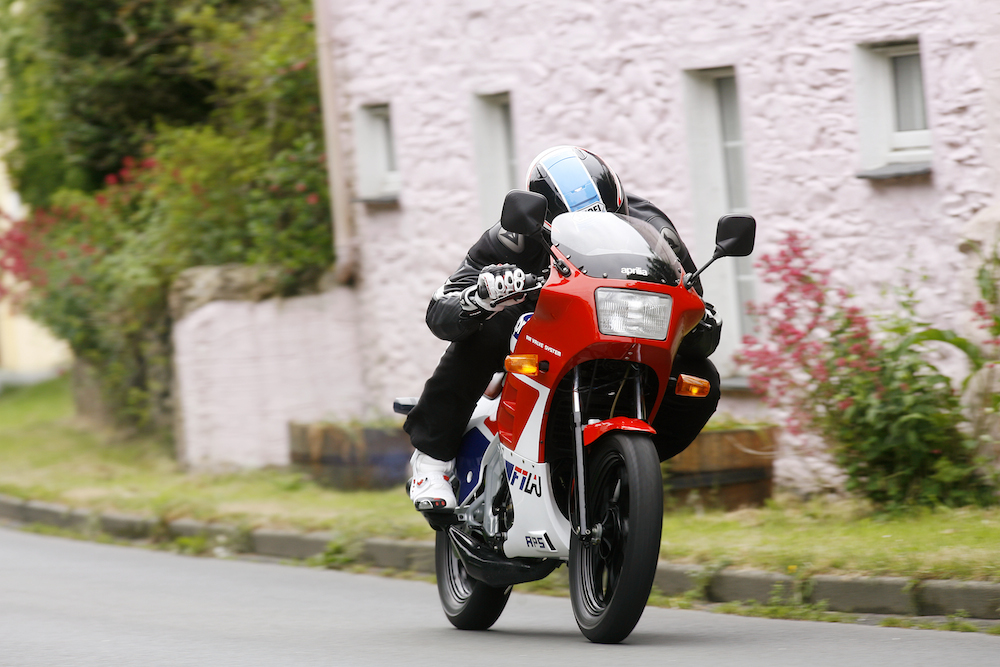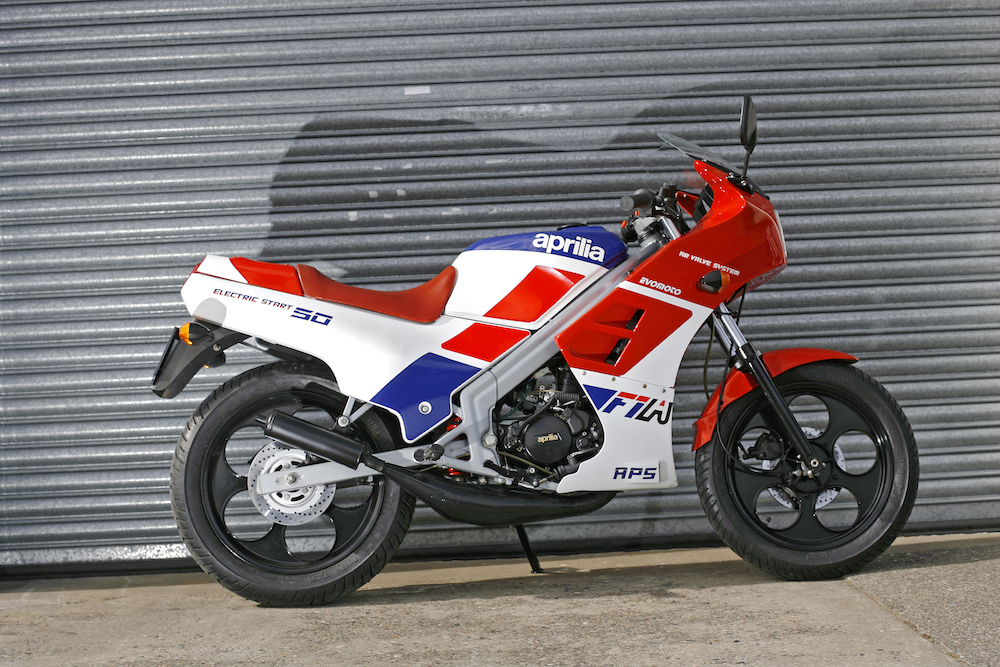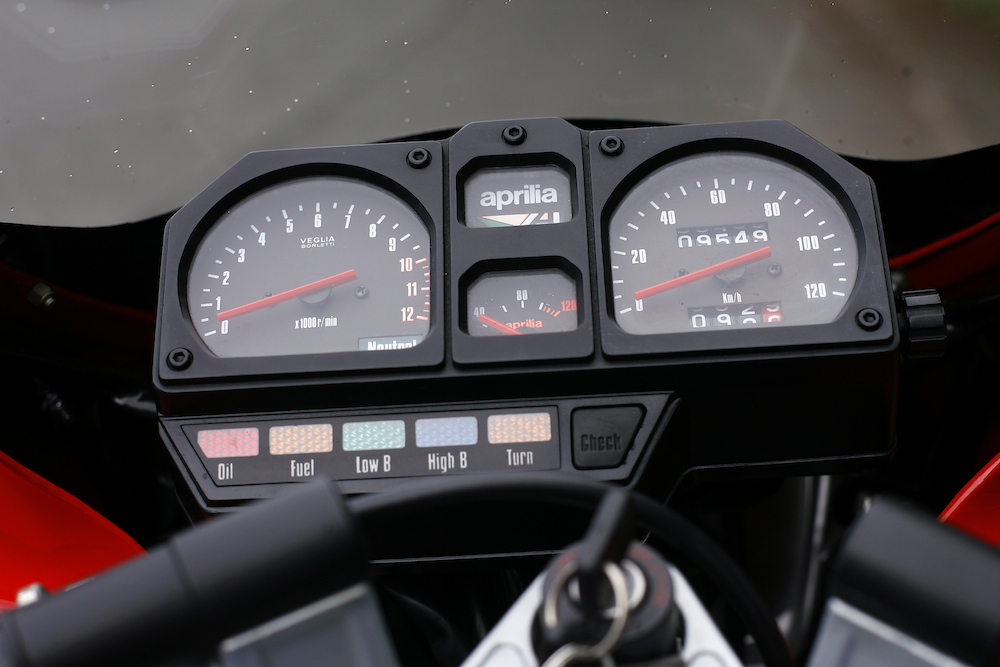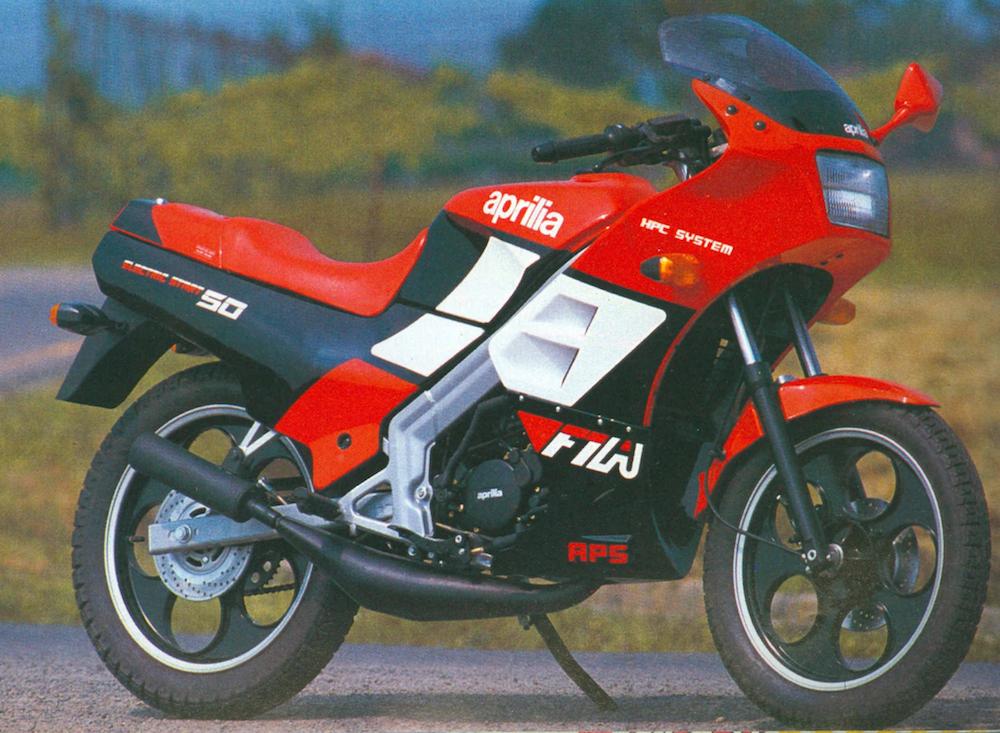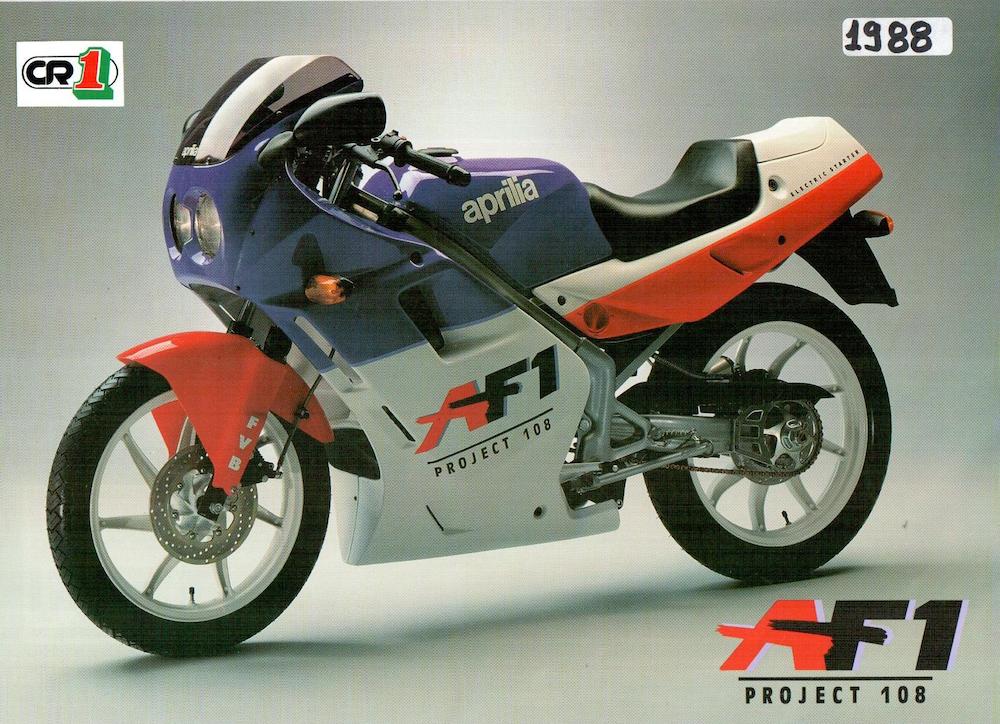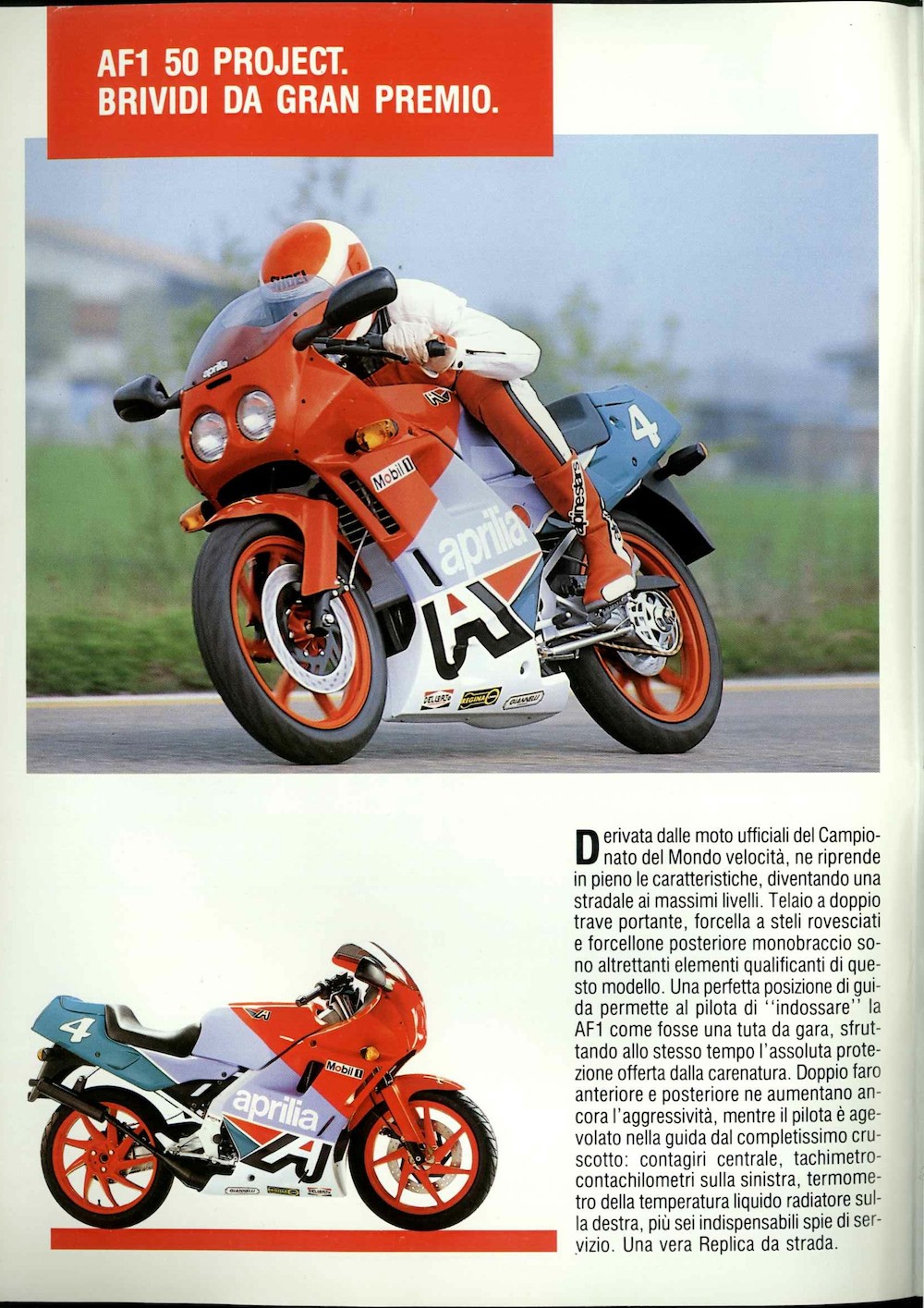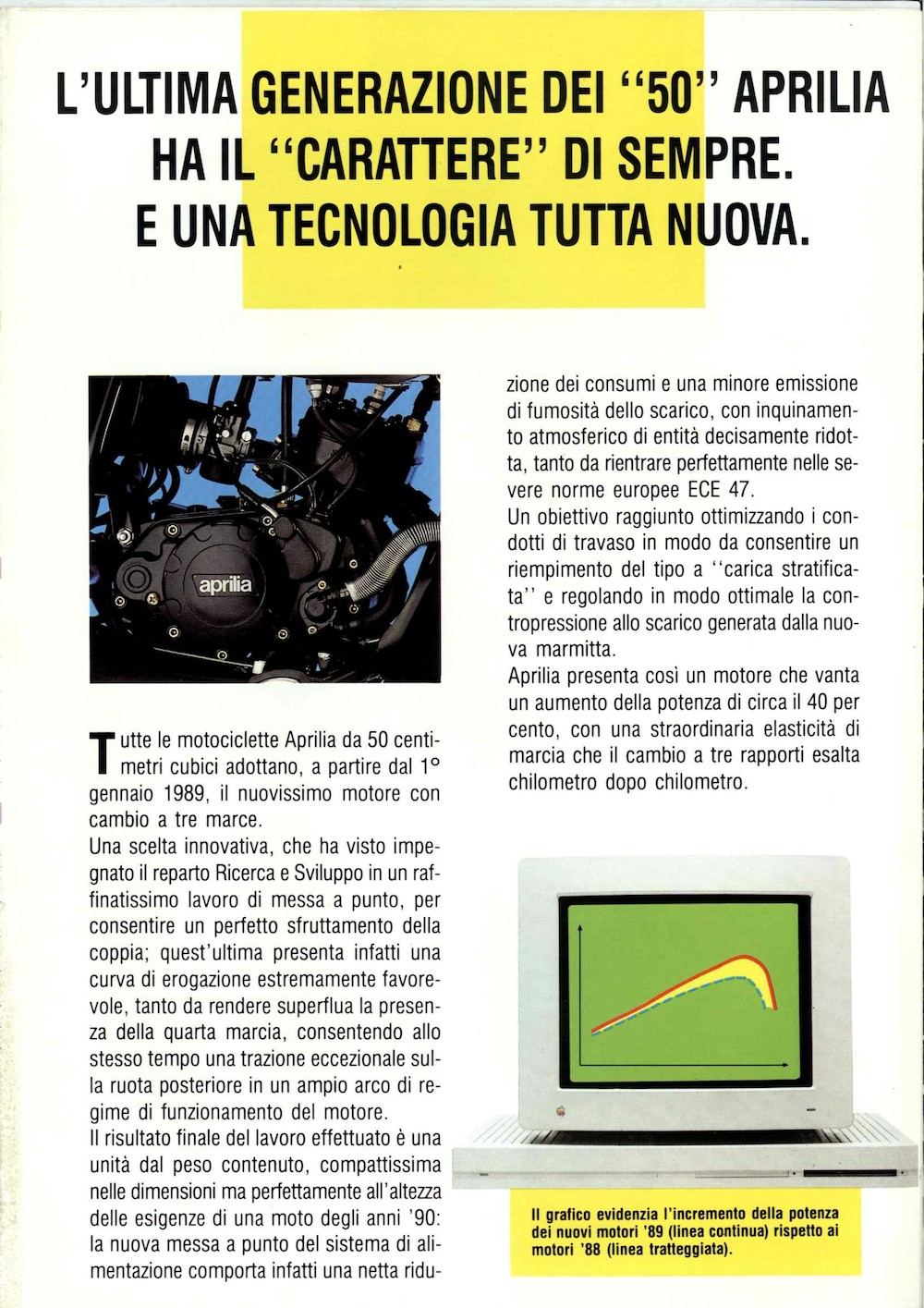1986/1987: AF1 50 – Tipo AB
La AF1 50 del 1986, tipo AB caratterizzata dal codice omologativo OM 52107, è il primo vero cinquantino stradale pensato come una moto di maggiore cilindrata. Fino ad allora l’unica seria proposta era la Malaguti RGT del 1984 che però ha ormai una linea antiquata con dotazioni di bordo superate.
Delle case italiane impegnate nella produzione di moto di piccola cilindrata, Aprilia è sempre stata la più attenta alle mode del momento e la più attiva nel presentare un prodotto giovane e che piacesse ai giovani. La piccola AF1 è quindi un’assoluta pietra miliare in questo senso.
La AF1 50 ‘86 è anche la prima AF1 in assoluto ad essere prodotta e difatti viene posta in vendita con un anno di anticipo rispetto alla sorella maggiore AF1 125 del 1987.
La AF1 è una moto che vuole entusiasmare subito e comincia a farlo proprio dal nome. Infatti, AF1 significa “Aprilia F1”, dove “F1” è un chiaro riferimento al mondo delle corse automobilistiche. Un’idea del marketing Aprilia che lega il termine F1, che significa eccellenza ingegneristica, al nome della casa di Noale.
La linea della piccola AF1 è veramente splendida e la vivace colorazione bianco/blu/rosso offre veramente qualcosa di nuovo ai quattordicenni dell’epoca. Nel corso del 1987 arriva anche una seconda colorazione rosso/nero. Il prezzo nel 1986 è di Lire 3.280.000 per la versione full optional che offre freno a disco posteriore ed avviamento elettrico. (Lire 2.980.000 per la versione base con freno a tamburo posteriore ed avviamento kick starter)
La ciclistica della AF1 50 è veramente degna di nota. Mai fino a prima si era osato tanto su un semplice cinquanta.
Il telaio perimetrale in acciaio lascia subito intendere le prestazioni che è capace di gestire sono ben superiori alla velocità codice. Le sospensioni si avvalgono di una forcella Aprilia da 30 mm e di un ammortizzatore posteriore abbinato alla sospensione APS che lavora su un forcellone in acciaio. L’impianto frenante si avvale di un disco anteriore da 220 mm ed al posteriore di un disco da 220 mm (o tamburo da 118 mm). Le ruote lenticolari sono da 16” all’anteriore e da 17” al posteriore.
Il motore è il conosciuto Minarelli RV4 a quattro rapporti con raffreddamento a liquido ed ammissione lamellare caratterizzato da un gruppo termico disegnato secondo specifiche Aprilia. Il medesimo gruppo termico che equipaggia anche le enduro Etx e Tuareg. Un ulteriore segno distintivo rispetto alla concorrenza che utilizza il medesimo motore, ma con gruppo termico “base”.
APRILIA AF1 50 PROJECT 108 ‘88
A due anni dalla presentazione della AF1 50, nel 1988 Aprilia rinnova profondamente la sua cinquanta stradale che ora assomiglia in tutto e per tutto alla sorella di maggiore cilindrata Sintesi 125.
Curiosamente, la nuova AF1 50 ’88 adotta il nome della AF1 125 ’87, ovvero Project 108. Un motivo probabilmente da ricercarsi nella volontà del marketing Aprilia di voler sottolineare l’adozione del forcellone monobraccio (chiamato appunto “progetto 108) che per la prima volta viene adottato su un cinquantino.
Solo una colorazione è disponibile ed il prezzo è di Lire 3.350.000 con, a differenza della precedente versione, avviamento elettrico e disco posteriore di serie.
Le modifiche apportate rispetto alla AF1 ’86 sono molte ed effettivamente la nuova AF1 50 ne esce come un modello inedito. Praticamente, solo il motore Minarelli RV4 e la strumentazione rimangono invariati. Vediamo le modifiche adottate:
- Nuovo telaio sempre in acciaio caratterizzato da un nuovo telaietto reggisella sempre saldato alla struttura.
- Le sospensioni vedono l’adozione di una forcella rivista nel funzionamento e di nuove piastre di sterzo. Al posteriore la conosciuta sospensione APS viene rivista per poter lavorare con il nuovo forcellone monobraccio in acciaio.
- L’impianto frenante è inedito e vede l’adozione di una nuova pompa freno anteriore, pinza freno e disco anteriore. Anche al posteriore viene adottata una nuova pompa freno posteriore, pinza freno e disco posteriore. Il diametro di entrambi i dischi rimane il medesimo della versione precedente, ovvero 220 mm.
- Le ruote a razze sono inedite nel disegno e mantengono il diametro delle precedenti, ovvero 16” all’anteriore e 17” al posteriore.
- Le staffe portapedane pilota sono sempre in acciaio e saldate al telaio, ma ora le pedane pilota sono in alluminio più piccole e sportive.
- Il ponte di comando adotta nuovi semimanubri ed un comando frizione nuovo.
- La marmitta adotta una nuova espansione ed un nuovo finale.
APRILIA AF1 50 ‘89
La AF1 50 ’89 riprende ancora una volta le linee della sorella maggiore di 125cc e per la prima volta viene proposta anche in versione Replica, dedicata al belga De Radigues che sostituisce Loris Reggiani per la stagione ’89.
La colorazione replica però non è l’unica offerta ed infatti viene introdotto un bianco/rosso che riprende quanto visto sulla precedente versione. Il prezzo nel 1989 è di Lire 3.640.000 con avviamento elettrico incluso.
Rispetto al precedente modello le modifiche sono concentrate in una nuova e più sportiva strumentazione Veglia Borletti che è praticamente identica a quella montata sulla 125 ed un nuovo disco a freno anteriore di grande diametro.
Il motore viene adeguato alle nuove normative Codice che ora limitano il numero dei rapporti al cambio solo a tre e viene adottato un nuovo gruppo termico. Il motore Minarelli viene quindi aggiornato ed assume il nome di RV3.
Vediamo quindi le modifiche apportate:
- Il musetto ha fari più piccoli e bombati anziché piatti come sulla precedente Project 108 ed ha una presa d’aria centrale che incattivisce l’aspetto. Il serbatoio è in plastica con copri serbatoio anch’esso in plastica con sportellino copri tappo chiuso con serratura.
- Nuova strumentazione Veglia Borletti con contagiri di grande diametro e contakm separato sulla sinistra.
- Il telaio è completamente liscio, anziché avere le travi discendenti ondulate, inoltre ha i paratacchi delle pedaline pilota saldate (assenti sulla Project 108).
- La forcella viene rivista e viene adottata una nuova piastra di sterzo con logo “AF1” stampato. La versione “B”, ovvero un aggiornamento di produzione, monta una forcella di secondo tipo con parapolvere rialzato. L’ammortizzatore ed il forcellone rimangono invariati, ma adottano una diversa tonalità di grigio nella verniciatura.
- L’impianto frenante rimane generalmente invariato, sebbene all’anteriore viene adottato un nuovo disco da ben 290 mm servito da una nuova pinza con un attacco diverso.
- Il motore Minarelli RV3 adotta un nuovo cambio limitato a 3 sole marce. Come conseguenza Aprilia ridisegna il gruppo termico che viene migliorato per favorire maggiore coppia e quindi cercando di limitare il disagio dato da soli tre rapporti. Si tratta di una modifica studiata da Aprilia ed adottata su tutta la gamma 50 ’89. In più, la AF1 50 adotta anche una nuova espansione con diverso finale. Variano i rapporti della trasmissione finale.
Probabilmente per smaltire i banchi motore RV4, su diversi RV3, l’ingranaggio del quarto rapporto viene semplicemente bloccato. Sugli RV3 di nuova produzione, viene invece rimosso del tutto. Pertanto, per capire se l’ingranaggio esiste o meno è sufficiente portare il cambio in terza marcia e “cercare” il rapporto superiore provando a muovere la leva del cambio. Se questa sale, senza ovviamente innestare il rapporto, significa che l’ingranaggio della quarta è presente e bloccato. Se invece, la leva non si muove, allora l’ingranaggio è stato rimosso.

